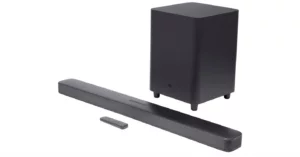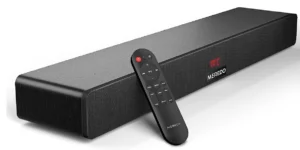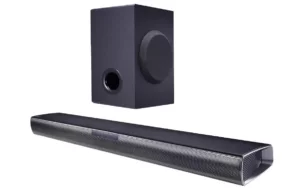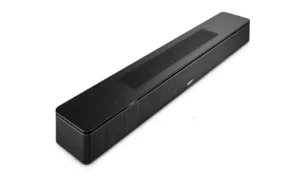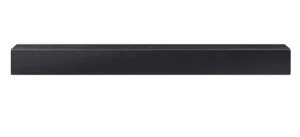
The Best Soundbars in Canada
If you’re tired of watching movies, TV shows, and listening to music on your television with a tinny, washed out sound – consider adding a soundbar into your home! They are generally discreet, can be budget friendly (more than most think!) and bring some bass surround sound that can escalate your listening and watching experiences.
With the plethora of soundbars and audio tech on the market, it can be overwhelming trying to figure out what you need and what numbers mean what. With our guide below we make sense of all of the numbers and what to look for based on what you’re looking for most in a soundbar.
Our top picks
What to look for in a soundbar
When it comes to buying a soundbar, keep these factors and questions in mind:
Where are you going to place it?
Soundbars can be as small as a small bar in front of your TV that you barely notice or be a full-blown home theater. Don’t overlook your current TV set-up, TV stand, and sort out where you need to place any soundbars you’re looking at purchasing. Most can fit underneath your TV in between the stands if your television isn’t wall mounted.
Soundbars themselves can be wall mounted easily or placed in front of your TV. The space you have around your setup might dictate which type of soundbar you should be looking for and that can influence where it needs to be for the best results. Soundbars are easy to install, plug in, and work immediately.
What size of soundbar should you be getting?
Ideally the soundbar you’re purchasing should be the same length as your TV and no bigger than it. Aesthetics are a large part for many people when they get a soundbar, so it is worth keeping in mind as well. For the most part, soundbars can work with any size of television, just as long as it is compatible with connectivity – especially if your television is older, in the 8-10+ years older than most other technology range, otherwise it will just be an expensive furniture piece underneath your TV.
What do passive or active soundbars mean and which do I need?
Passive and active in regards to soundbars essentially is the difference between having a soundbar that has built-in amplifiers or not. Passive means that the soundbar doesn’t have a built-in power amp, meaning that you would need to have a receiver or amplifier for it to work, but they do tend to have better speakers, which equals better sound. Passive soundbars will cost more as you need the additional components and you will need a traditional subwoofer connection if you want extra bass from your output.
Active means that the soundbar comes with built-in amps that power everything as well as channel processors that separate right, left, and center speakers in the soundbar. No extra receiver and less wires to have to fuss with, as it’s an all-inclusive device that’s ready to be plugged in and installed easily. If you’re looking to upgrade the sound your TV is outputting, getting an active soundbar will still easily upgrade the audio into a home theater. Passive soundbar channels are great for customization style builds if you’re looking into making a full home theater or looking to hide the soundbar with the TV or etc.
What are channels and what do the numbers mean?
Channels are best thought of as individual speakers/sound sources and the numbers correlate to that. Most movies and shows offer five different audio channels (and even more if it’s surround sound) that are all embedded digitally: Left, center, right, two rear, or more.
2-channel soundbar: Two speakers, one on the left and one on the right.
3-channel soundbar: Three speakers, left/right, and center
5-channel: All speakers above that we mentioned are included in 5-channel soundbars and are still considered the standard for home theater setups. Left/Right/Center/Two rear speakers.
7-channel: Seven speakers is the same as a 5-channel setup, but with a bit of a bonus as the surround and rear channel information is split so that you get seven instead of five. It is quickly becoming the new go-to when it comes to creating home theaters.
Dolby Atmos Surround soundbars: These are in their own level when it comes to a home theater. What makes it different from the other 5 and 7-channel soundbars is that you have upward firing speakers located in the soundbar that reflects sound above that creates a three-dimensional soundstage. Soundbars like these work best in rooms that have flat ceilings that are up to 11-feet high.
The numbers when it comes to channels are simpler than most may think and are easy to decipher. A 5.1 surround sound means that it has 5 speakers and 1 subwoofer. A 7.1.4 channel soundbar would have 7 speakers in the soundbar, 1 external subwoofer, and 4 extra speakers that can go around your television.
The more channels the better, essentially!
How do I connect a soundbar to my TV?
Connecting a soundbar to your TV is easier than ever, as most of them are installed using HDMI ARC. You simply plug it into an open HDMI port on your TV (and plug it into a socket as well for power, of course) and that’s it! You can control it using your regular TV remote and don’t need to fuss or deal with any other components or wires. It’s as easy as it comes.
Bluetooth and Wi-Fi allow you to stream audio directly from your soundbar or from your phone/tablet without any issues. Many soundbars today come with built-in Bluetooth and the Wi-Fi enabled soundbars allow you to connect to your home network to seamlessly connect to Spotify, Pandora, etc. other audio apps you might use.
USB inputs might be used for firmware updates, and most soundbars will download their own software updates automatically without the need for doing anything at all yourself. These are most likely not needed or necessary. Any good wireless soundbar will easily work as a stereo without a hitch once its connected to any devices with music that you’d like.
Do I need separate speakers and a subwoofer?
Not unless you purchase a soundbar that doesn’t have a built-in subwoofer, or if you’re looking to fully customize your home theater set-up with multiple speakers and stands. Some newer soundbars come with their own external speakers to bring you closer to a better home theater system sound and feel. If the soundbar is multi-room capable, then you’re able to add wireless rear speakers or more. A subwoofer is generally shipped with your soundbar/included as is, and if not, they typically will have an incorporated subwoofer port so that you can add your own.
What are the common prices for soundbars?
Prices for quality soundbars can be generally put into these categories:
- $100 or Under
You can find quality soundbars in this price range, surprisingly easier than you would think! If you’re looking to find something that will simply enhance your TV and its audio and aren’t ready or wanting to jump into the deep end with surround sound audio, they’re a great option for budgeting or just wanting to step up your television watching. This price range is also great for smaller rooms and TV’s that aren’t the main/primary viewed ones.
- $100 to $300-400
For non-surround sound soundbars, they generally fall into this range. Samsung, Sony, Polk, Vizio, Bose, etc. are all in this range and offer a great upgrade to your TV. In this price range, you should purchase and look for a soundbar that has a wireless subwoofer included. Some models are alright without them, but you are losing the deeper bass features that can really escalate a soundbar from good to great.
- $400 to $1,000
High-quality surround sound soundbars tend to start around this price range, especially ones that have included real satellite speakers and subwoofer capabilities without a compromise. A high-end system that can be expanded later such as a Sonos would fall under this category for being alright to purchase without satellite speakers.
- Over $1,000
If you’re looking for a top of the line, customized true home theater experience – this is the price range you’ll find it in. You can easily build out a true home theater room. Speakers, amps, and receivers can be included in this and any soundbars will fit into this budget.
The best soundbars in Canada
JBL 5.1 Soundbar
This JBL surround sound soundbar delivers 550W total system power, includes a 10” wireless subwoofer that delivers deep, crisp sound. Has a built-in Chromecast, Airplay, and Bluetooth capabilities, and brings a 5.1 surround sound experience to your TV. Livening up your living room to watch TV, movies, or even play video games has never been easier.
4K pass-through with HDR 10 and Dolby Vision provides clean and clear resolution. It has and supports multi-room audio if you need or want to extend the experience to other places in your home or add more speakers. No extra wires or speakers needed though and it includes its own subwoofer.
Pros
- Immersive 5.1 surround sound.
- Easy setup with HDMI.
- Built-in Chromecast.
Cons
- The subwoofer can overpower the soundbar and make audio ‘too bassy’ if you’re not someone that likes deep heavy bass tones.
MEREDO Soundbar
The MEREDO soundbar is made of high-density wood materials and allows the music to be deep and crisp without compromising sound quality. It is a 2.1 channel soundbar, that has two speakers and a built-in subwoofer. The speakers are full range and the subwoofer itself is 4-inches that emphasizes bass to 35Hz. It also has optimized sound for various applications and provides 5 different EQ modes such as Film, News, Music, Bass+, Treble +, and you can manually adjust treble and bass from -5 to +5, (10 level intervals) to match and fine tune your hearing experience while watching shows and movies.
An HMDI ARC cable (included with the soundbar) easily allows you to connect to your TV without any fuss or extra wires needed and you need to just use your regular remote to control the sound and settings. It supports ARC, Optical, AUX, and USB connections as well if needed and it comes with an automatic LED screen-off function that won’t be a distraction while it’s on. It doesn’t support wall mounting however, so if you’re looking to attach this to your wall, you may want to look into a different soundbar.
Pros
- Customizable treble and bass settings.
- Built-in subwoofer.
Cons
- Does not support Dolby/DTS sound.
LG SQC1 Soundbar
Compact and well worth the bang for your buck, the LG SQC1 soundbar includes an active wireless subwoofer that allows for wonderful sound quality without having to sacrifice style or space. It has a big 160W sound and is compact enough to blend into your décor if you have it in front of your TV.
Bluetooth streaming wirelessly allow you to stream music directly from your smartphone, tablet, or PC (as long as they are compatible devices) for a seamless music listening experience without having to use your televisions tinny sound. Available on demand sound starts the moment you transfer audio to the soundbar, as the soundbar itself will remain in sleep mode but turns on once the audio is sent via Bluetooth or otherwise. The LG SQC1 comes with its own remote but you can easily use your regular TV remote as well – though keep in mind that some brands may not work. Most do, including LG, Sony, Phillips, Sharp, Panasonic, Vizio, Toshiba, and Samsung. Others may work, but you might want to use the included remote if not.
It has Dolby capability and does allow for wall mounting as well, if you’re looking to do so with a soundbar.
Pros
- Supports wall-mounting.
- Has Dolby capability.
- Solid design and sound.
Cons
- May not be clear or bassy enough for some users.
Bose Smart Soundbar
BOSE is well known for their electronics and audio accessories, and the Smart Soundbar 600 is no exception.
The Smart Soundbar 600 is a Dolby Atmos soundbar that also features proprietary Truespace technology and two upward firing transducers to deliver shockingly immersive sound for all of the TV shows, movies, music, and games that you want to bring to the next level. No matter what you’re watching or listening to, Bose’s TrueSpace technology intelligently analyzes signals other than Dolby Atmos, such as stereo or 5.1, and upmixes them to create a custom immersive multi-channel sound experience. Acoustic architecture manages to squeeze 5 speakers (including the two upward firing ones) into a small 27.5” wide soundbar that will easily spread across the room – horizontally left and right, forward, and overhead.
It is a wireless soundbar perfect for streaming music from your smartphone or tablet, or even PC – as it utilizes Spotify, Apple AirPlay 2, Chromecast, etc. and included with this soundbar is Amazon’s Alexa voice control if you use it. Along with Google Assistant capabilities with a compatible Google device. An included remote and the Bose music app allows for quick access to your music whenever you want to listen.
Pros
- Amazing sound quality.
- Great price and design.
- Easy setup.
Cons
- May not be compatible with Dolby Atmos.
Samsung HW-C400 Soundbar
Samsung’s C-Series soundbar is a Bluetooth/NFC capable soundbar that delivers wonderful 3D sound without upward firing speakers. There are multiple options to this soundbar, including one that has 2 speakers and a subwoofer or a 3-channel version with a subwoofer as well.
The surround sound expansion expands the listening area both sideways and up to emanate sound better around your living area. An interesting mode is that this has a Night mode that is ideal for late night viewing, it reduces the overall decibels during the night, and especially compresses bass so that you don’t have to worry about neighbours or waking up anyone that’s sleeping. The included Samsung TV remote allows you to control both your TV and any key soundbar functions such as the volume, power, and sound effects.
Bluetooth and NFC capabilities allow you to easily stream your favourite music and listen directly from the soundbar without having to go through settings and other frustrating issues. The soundbar is easily setup by simply plugging it in, placing it where you want it, and using the app and remote.
Pros
- Great sound with DTS Virtual X 3D sound.
- Night Mode is great for late-night TV users.
- Bluetooth capable.
Cons
- Cables can be a bit tough to connect.
- Wall mounting may be difficult.
Read more

The Best Wireless Headsets in Canada
These wireless headsets let you talk and listen hands free.

Sennheiser CX True Wireless Earbuds Review
Looking for a good pair of wireless earbuds at a reasonable price. Check out this review to learn more.

The Best Wireless Headphones in Canada
Tired of untangling earphone wires? That’s where a pair of good wireless headphones come in handy.

Microsoft Surface Headphones 2 Review
Are you looking for a pair of wireless headphones. This pair from Microsoft may be the one for you
